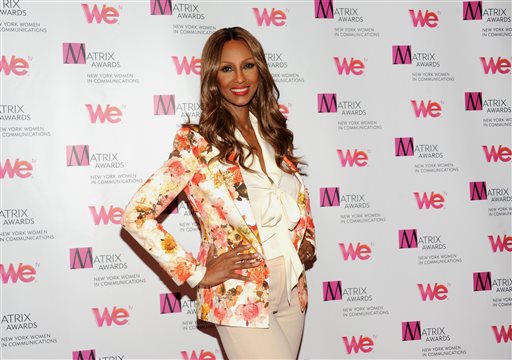
NEW YORK — Supermodel Iman didn’t plan on becoming a prominent voice for black models and entrepreneurs, but since it happened that way, she’ll use the pulpit she’s been given.
She hopes her 13-year-old daughter is listening.
Being a good mother and wife (to David Bowie, no less) is a priority. Her businesses come next. But she’ll always have an interest in fashion, the runway, photographers — even the next It bag.
Last month, Iman, veteran modeling agent Bethann Hardison and fellow supermodel Naomi Campbell launched the Balance Diversity campaign, which included open letters to organizers of fashion weeks in New York, London, Paris and Milan that called out designers whose catwalks were almost entirely white. Later this week, she receives the BRAG Legacy Award for promoting “diversity from a retail point of view.” (BRAG is a nonprofit organization that prepares and educates professionals, entrepreneurs and students of color for executive leadership in retail, fashion and related industries.)
Iman said she’s seen progress on the catwalk during the most recent round of fashion shows, adding that some players in the industry had said they didn’t realize what was happening.
“Someone had to say it,” she said. “It’s sort of like with my daughter when I have to scold her. She’s not a bad girl, but did a bad thing.”
In a recent interview, Iman talked about taking a stand for diversity, the modeling world and her plans for the future.
AP: Why take a stand now?
Iman: My dearest and closest friend Bethann called and said, ‘You wouldn’t believe it! There are less black models on the runway than when you stopped doing it in 1989.’ Now, I haven’t seen a fashion show in years, but I do see online what I’d wear. But I wasn’t aware that so many black models weren’t working, and I was so disheartened that young models were being told by casting agents, ‘Designers are saying they don’t need to see black models this season because it doesn’t fit their aesthetic.’ You have to think of this through a 13-year-old’s eyes, and I don’t want her to be discouraged.
AP: Your recent professional life has focused more on developing your makeup brand and designing for HSN. Would you like to take on a larger role in the modeling world?
Iman: I have got a 13-year-old. I have my hands full. I can’t be a full-time mentor, so I won’t be hanging my name outside a modeling agency anymore. … But I do want a diverse world.
AP: Did you expect to become a spokeswoman for the next-generation model?
Iman: I didn’t expect longevity ESPECIALLY as a model. I thought it would last two years, and I started in 1975. I didn’t even know if I’d be relevant now.
AP: What’s been your secret?
Iman: What I’ve built it all on — and I’m at 58 now — is that I don’t try to keep up with the Joneses. I try to be consistent. People want to change their images at the drop of the hat. They always say ‘newness.’ But I’ve always built my business (on the idea) that I don’t want to go with the flow — I want to create the flow.
AP: What comes next?
Iman: What’s next — I have absolutely no idea. Whatever I create … it has to be authentic. I have to do something that’s truly me. It’s not about my ego or my name. Product is king — or queen, for that matter.